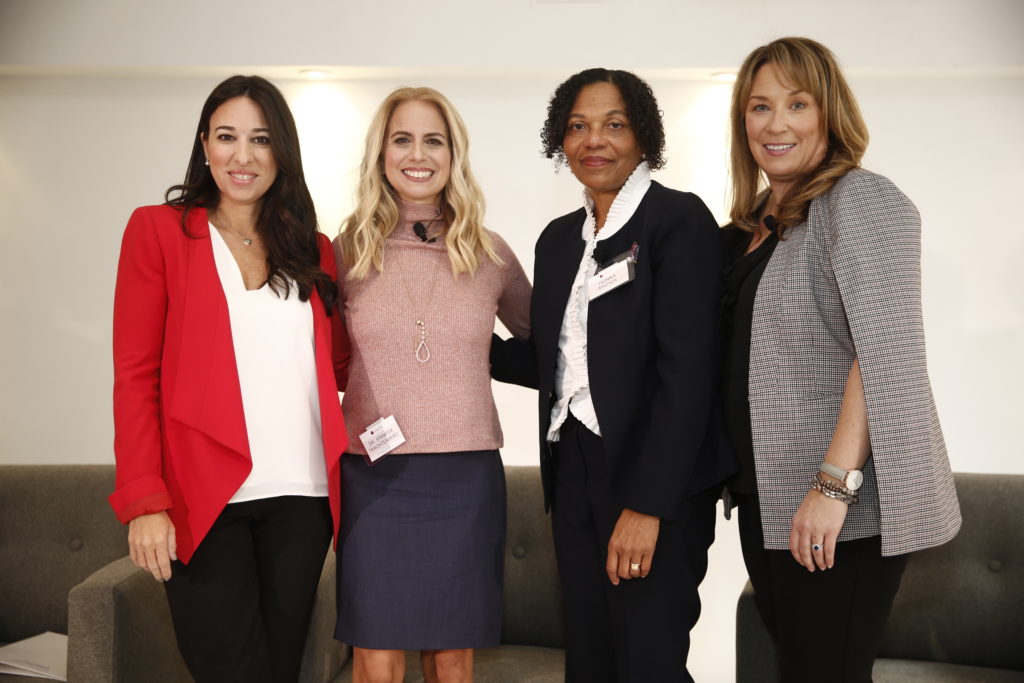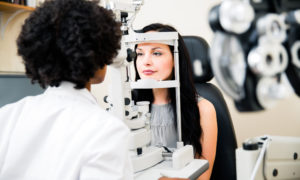By Margery Weinstein
ROB Executive Editor

Left to right: Melissa Musen Gerstein, co-founder of the multi-media company, The MOMS, and facilitator of the discussion; Jen Trachtenberg, MD, pediatrician and author; Donna Mazyck, executive director of the National Association of School Nurses; and Michele Andrews, OD, senior director, North America Professional and Academic Affairs, CooperVision.
Nov. 13, 2019
An event sponsored by CooperVision last week in New York City spotlighted new research showing how much parents need to learn about myopia. Featuring a panel with guest speakers, new Harris Poll survey results were shared and discussed to find ways to better serve children.
The prevalence of digital devices means that all children today may be at greater risk for myopia, said Jennifer Trachtenberg, MD a pediatrician in New York City, who spoke on the panel to an audience of trade and consumer journalists sitting behind desks arranged classroom-style while sipping red and white sangria from containers meant to look like juice-boxes. “Parents give a phone or iPad to a child to self-sooth,” she said.
That heavy digital device use is coupled with parents who know little-to-nothing about myopia, and the risk it poses to children’s development and eye health.
One-in-four children in the U.S. is myopic1, but according to The Harris Poll survey results released the day of the event by CooperVision, only 33 percent of parents know what that term means2, or how it can affect their children’s future eyesight.
The survey was conducted among eyecare professionals (ECPs), including 155 optometrists and 158 ophthalmologists and 1,005 parents with children between 8-15 years old regarding their knowledge of myopia.
The impact of myopia is important for parents to understand, as it can adversely affect their development said Donna Mazyck, executive director of the National Association of School Nurses. “Children need all their senses to learn. They’re building visual skills and seeing things from different perspectives. We need to be aware of vision,” she said.
The eyecare community has confirmed what pediatricians and school nurses like Dr. Trachtenberg and Mazyck have suspected–they are, indeed, seeing more cases of myopia.
Two-thirds of ECPs (66 percent) have seen an increase in the prevalence of pediatric myopia in their practice over the last 5-10 years3, which aligns with data from the American Optometric Association (AOA), showing myopia has become increasingly prevalent in recent years, with an increase of 25 percent in the past 40 years.
New Resource
Around one-quarter of parents (26 percent) have a nearsighted child, and about three-quarters of those children were diagnosed between the ages of 3 and 121. But even though this condition is increasing, and the severity is getting worse, there are many misunderstandings surrounding myopia, what it is and why it is important for children to have their eyesight checked regularly by an ECP.
As the eyecare community learns more about the risk to eye health and children’s development posed by myopia, it is important for doctors to pass that information along to parents, including the warning signs of myopia, says Michele Andrews, OD, senior director, North America Professional and Academic Affairs at CooperVision.
“We are learning that even lower myopia prescriptions have consequences,” Dr. Andrews said. And even as those consequences become more apparent, the ability of children to notice themselves that they may have a vision problem has not changed. “Most children don’t know they don’t see well,” she noted, sharing that even as an optometrist, she did not know that her own child was having a visual challenge in one eye.
There sometimes are tell-tale signs of a visual challenge, such as a child who tips their head to one side when doing homework, but often there are no signs at all. “It really requires a comprehensive exam,” says Dr. Andrews.
Other highlights from the survey include:
• 97 percent of ECPs agree parents should know more about the ways they can help protect their children’s vision.3
• 73 percent of parents strongly/somewhat agree that teachers are more likely to notice that children have vision problems 2; 68 percent of parents strongly/somewhat agree that school nurses often notice potential vision problems among children before parents.2
• Parents say they are more knowledgeable about other childhood conditions including the flu (93 percent), ear infections (86 percent) and lice (80 percent) compared with their knowledge of myopia (65 percent).2
• 22 percent of parents report the top reason prompting an ECP visit is an in-school eye screening2, whereas 92 percent of ECPs state this is the top reason for parents seeing them for their child’s vision.3
References
1. Cooper, Y. (2019, May 1). With Childhood Myopia Rates on the Rise, the American Optometric Association Highlights the Importance of Early Intervention through Annual Eye Exams. Retrieved from https://www.aoa.org/newsroom/myopia-rates-on-the-rise-syvm
2. CooperVision data on file 2019. Myopia Awareness, The Harris Poll online survey 6/27/19 to 7/18/19 of n=1,005 parents (with child age 8-15) in U.S.
3. CooperVision data on file 2019. Myopia Awareness, The Harris Poll online survey 6/27/19 to 7/18/19 of n=313 ECPs (who see at least 1/month myopic child, age 8-15) in U.S.
























